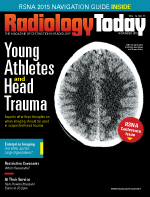 November 2015
November 2015
Radiology Billing and Coding: Professional and Technical Components
By G. John Verhovshek, MA, CPC
Radiology Today
Vol. 16 No. 11 P. 7
Most radiology services or procedures, although described by a single CPT code, comprise two distinct portions: a professional component and a technical component.
The professional component is provided by the physician, and may include supervision, interpretation, and a written report. To claim only the professional portion of a service, CPT Appendix A ("Modifiers") instructs you to append modifier 26, professional component, to the appropriate CPT code. Modifier 26 is appropriate when the physician supervises and interprets a diagnostic test, even if he or she does not perform the test personally.
The technical component of a service includes the provision of all equipment, supplies, personnel, and costs related to the performance of the exam. To claim only the technical portion of a service, append modifier TC, technical component, to the appropriate CPT code. Fees for the technical component are reimbursed to the facility or practice responsible for these costs.
Hospitals typically are exempt from appending modifier TC because it is assumed that the hospital is billing for the technical component portion of any onsite service. Consult individual payers for specific coding instructions.
The surest way to identify codes with separate professional and technical components for Medicare payers is to consult the National Physician Fee Schedule Relative Value File, available as a free download from the Centers for Medicare & Medicaid Services (CMS) website. The most recent file as of September 2015 can be found at www.cms.gov/Medicare/Medicare-Fee-for-Service-Payment/PhysicianFeeSched/PFS-Relative-Value-Files.html. If the Relative Value File lists separate line items for a code with modifiers 26 and TC, the service or procedure described by that code includes both a technical and professional component.
For instance, the 2015 Relative Value File lists three separate lines for 74020, Radiologic examination, abdomen; complete, including decubitus and/or erect views. The first of these lines corresponds to the "global" service. The second line details the technical component only, and the third line describes only the professional component. Note that the separate relative value units (RVUs) assigned for the technical and professional components will equal the total RVUs for the global service (described below). The total RVUs for 74020 are 1.04, of which 0.66 RVUs are attributed to the technical component and 0.38 are attributed to the professional component.
Example 1
A chest X-ray is performed in a freestanding radiology clinic, and a physician who is not employed by the facility interprets the films. The clinic will append modifier TC to the appropriate chest X-ray code (eg, 71010-TC, Radiologic examination, chest; single view, frontal-technical component) to account for the cost of supplies and staff. The physician who interprets the X-ray submits a claim with modifier 26 appended (ie, 71010-26). The fee for the service will be split, with approximately 60% of payment allotted for the technical component, and 40% for the professional component.
A global service includes both the professional and technical components of a single service. When reporting a global service, no modifiers are necessary to receive payment for both components of the service. If the provider who interprets the film also owns the equipment, a global service is submitted and the professional and technical components are billed together (eg, the appropriate CPT code is reported without either modifier 26 or TC appended). The global procedure code is submitted at full fee.
Example 2
Code 72040, Radiologic examination, spine, cervical; two or three views, includes both a technical component (the X-ray machine and necessary supplies and clinical staff to support its use) and a professional component (physician supervision, interpretation, and report). If spinal X-ray is performed at the physician's office, either by a physician or a technician employed by the practice, report 72040 without a modifier because the practice provided both components of the service.
Note that radiologists who provide services for Medicare patients in a hospital or facility setting cannot claim the technical component of a procedure. Under the diagnosis-related group, the hospital/facility receives compensation for the technical portion of Medicare inpatient services. Similarly, Medicare rules require that payment for nonphysician services provided to hospital patients (such as the services of a technician administering a diagnostic test) are made to the hospital.
Although the majority of 7XXXX-series codes do include technical and professional components, if the fee schedule does not list separate values for a code with modifiers 26 and TC (eg, 77071, Manual application of stress performed by physician or other qualified health care professional for joint radiography, including contralateral joint if indicated), the modifiers are not appropriate with that code under any circumstances.
— G. John Verhovshek, MA, CPC, is managing editor for AAPC, the nation's largest medical credentialing organization.

